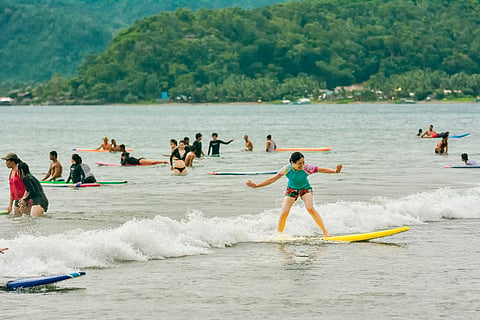
- Destinations
- Experiences
- Stay
- What's new
- Celebrating People
- Responsible Tourism
- CampaignsCampaigns
- Subscribe
- Buy Now

Released in 1979, Apocalypse Now is an iconic American psychological epic war film directed by Francis Ford Coppola, one of the leading figures of the New Hollywood era. Loosely based on Joseph Conrad’s Heart of Darkness, the film transposes the story’s haunting moral descent into the chaos of the Vietnam War. Known for its surreal imagery, strong performances, and themes of madness, morality, and the dark side of human nature, Apocalypse Now remains one of cinema’s most ambitious and influential works.
While the story unfolds deep in Vietnam and Cambodia, most of the film was shot in the Philippines — its jungles, rivers, and beaches serving as the stand-in for war-torn Southeast Asia. From the storm-battered shores of Baler to the winding Pagsanjan River and the dense forests of Laguna and Zambales, Coppola transformed the archipelago into a cinematic battlefield that became as infamous as the film itself.
The coastal town of Baler, on the eastern shore of Luzon, became the unlikely backdrop for one of Apocalypse Now’s most iconic scenes — the thunderous “Ride of the Valkyries” helicopter attack. The now-famous Sabang Beach and Baler Bay doubled as a Vietnamese coastal village under assault, their rolling surf and vast Pacific horizon lending the sequence its legendary cinematic scale. It was here that Robert Duvall’s Colonel Kilgore uttered his most famous line, “I love the smell of napalm in the morning.” The intensity of the beach landing scenes became part of Hollywood legend, but the production left behind more than stories of chaos — it introduced surfing to the locals. The leftover boards from filming sparked a seaside culture that would turn Baler into the surfing capital of the Philippines. Today, visitors can still trace Coppola’s cinematic footprint between surf shacks and beachfront cafés, where movie magic once met the Pacific wind.
Many of Apocalypse Now’s river journey sequences — including the haunting upriver voyage toward Colonel Kurtz’s compound — were filmed along the Pagsanjan River (also known as the Bumbungan River/Magdapio River) in Laguna Province. The river’s dramatic bends, dense jungle canopy, and misty atmosphere perfectly mirrored the psychological descent of Captain Willard’s mission. The film’s climactic tone — encapsulated in Marlon Brando’s chilling whisper, “The horror… the horror” — seemed to echo in the mist and shadows of the river itself. Pagsanjan was already a well-known natural attraction, famous for its waterfalls, and the film further cemented its cinematic mystique. To this day, boatmen along the river proudly point out spots where the movie’s haunting journey came to life.
The production also set up in Iba, Zambales, where large-scale sets were constructed for several war sequences. However, disaster struck when Typhoon Olga, locally known as Didang, hit the region in 1976, destroying much of the set and forcing an expensive, months-long production delay. Despite the setback, the area’s thick jungles and remote landscapes proved essential in capturing the eerie, suffocating feel of Vietnam’s war zones. Iba’s natural topography — wild, lush, and unpredictable — matched the psychological turmoil the film sought to depict.
The interiors of Colonel Kurtz's compound were filmed at Casa Real in Pakil, Laguna. This historical building, located just a kilometre from the town centre, served as the backdrop for some of the film's most intense scenes, including the climactic moments involving Kurtz and Willard.
Though most of the action took place in rural locations, Metro Manila played an important role behind the scenes. The capital served as a base for production logistics, housing cast, crew, and equipment during the long, tumultuous shoot. Some smaller indoor sequences were also filmed in and around Manila studios. Coppola worked closely with the Philippine government and military, who provided helicopters, pilots, and logistical support — a collaboration that became one of the most talked-about aspects of the film’s legendary, chaotic production.
From Luzon’s rivers to its Pacific shores, the Philippines gave Apocalypse Now its haunting physical and emotional terrain — landscapes both breathtaking and brutal. Decades later, these sites remain cinematic landmarks, where travellers can still sense the madness, beauty, and myth Coppola captured — proof that, as Willard once reflected, “The war was in here.”
1. Where was Apocalypse Now filmed?
Most of Apocalypse Now was filmed across the Philippines, including Baler (Aurora), Pagsanjan (Laguna), Iba (Zambales), and Metro Manila. Some parts were also shot in Napa, California.
2. Why was the Philippines chosen as the location instead of Vietnam?
Due to political instability in Vietnam at the time, the Philippines offered a similar tropical landscape, government support, and military assistance for production.
3. Is Baler, where the helicopter scene was filmed, open to tourists?
Yes. Sabang Beach in Baler is now a popular surf destination, where locals still recall the filming of the iconic “Ride of the Valkyries” scene.
4. Can visitors still see the Apocalypse Now river locations?
Yes. The Pagsanjan River, used for the movie’s upriver scenes, remains a major tourist attraction with guided boat tours through the same stunning landscapes.
5. What lasting impact did Apocalypse Now have on the Philippines?
The film boosted the country’s recognition in global cinema and even introduced surfing culture to Baler, turning it into the surfing capital of the Philippines.
